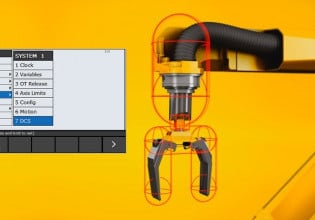Visualize This: Rockwell Introduces New OptixPanel HMI for Process Optimization
Rockwell Automation introduces a new line of more modern, flexible, and customizable human-machine interface (HMI) solutions for machine builders: the new OptixPanel graphic terminals.
Globally renowned automation leader, Rockwell Automation, has introduced a new range of graphic terminals. The Allen‑Bradley OptixPanel graphic terminals come in different design configurations to provide independent network operation and adaptability for different application sizes. OptixPanel graphic terminals serve as human-machine interface (HMI) components. They act as a bridge between industrial machines and processes and their human operators, enabling users to view, control, and optimize the machinery or systems in a visual and user-friendly way.

OptixPanel graphic terminals do not require antivirus software because there is no access to the operating system. Image used courtesy of Rockwell Automation
Application Flexibility
The graphical terminals are available as compact and standard versions, with the OptixPanel Standard graphic terminal able to operate on two independent networks with separate ports. Customers can choose from a range of screen sizes, bezel options, single-touch or multitouch screen modes, and swipe or pinch modes of interaction.
With two USB 3.0 connectors and two Gigabit Ethernet ports, the OptixPanel Standard graphic terminal has a broad range of connectivity possibilities. It permits FactoryTalk Remote Access to interface with devices on the local subnetwork and features a single isolated DB9 serial port. The terminals also come with a FactoryTalk Remote Access Runtime Pro license and a FactoryTalk Optix Runtime license, varying between small (8 feature tokens), to large (15 feature tokens) for various sizes of panels. These feature tokens provide a link between a single device and a remote (or cloud) server to correlate process data for inputs, indicators, switches, etc.
The standard terminals come in a range of screen sizes from 7 to 21.5 inches, while the compact terminal is available within a narrower range of sizes, from 4 to 7 inches.

FactoryTalk Optix can recognize the intended system's screen size and adjust itself, thanks to scalable vector graphics and responsive rendering. Image used courtesy of Rockwell Automation
The OptixPanel Compact graphic terminal shares similar features to the standard version, but there are some slight differences. The OptixPanel graphic terminal offers a variety of bezel alternatives as well as touchscreen technologies. These include an aluminum widescreen with a single-touch analog resistive screen and an aluminum and glass widescreen with a PCAP multitouch screen that supports gestures like swipe and pinch.
There are several communication choices available, including one USB 2.0 connector, one non-isolated DB9 serial port, and a Gigabit Ethernet port. With the ability to upgrade to 11, the terminal may operate FactoryTalk Optix with 8 feature tokens. FactoryTalk Optix Runtime small license (8 feature tokens) and FactoryTalk Remote Access Runtime Basic license (upgradable to Pro license) are included with the package.
Durability
The stainless steel models have one of the strictest and highest degrees of protection in the IP rating system, IP69K. It is frequently used for machinery, food and beverage production equipment, medicines, agricultural equipment, and heavy gear that must survive hostile environments.
For the uninitiated, the "6" in IP69K stands for the greatest level of dust protection, ensuring that no dust particles can enter. The "9K" stands for the greatest standard of defense against water intrusion, particularly high-pressure water jets. Thanks to the IP69K classification, the system is protected from high-pressure, close-range, high-temperature washdowns, making it appropriate for applications requiring intensive cleaning.
FactoryTalk Integration
The OptixPanel Graphic Terminals are connected to the FactoryTalk Optix visualization software. This combination allows users to develop HMI projects independently or as part of a collaborative team in the cloud with SaaS-enabled workflows. A tablet, workstation, or mobile display can be deployed singly or in a distributed fashion (across a facility floor, for example) to enhance interoperability. Interoperability is also enhanced through the integration of OPC-UA and Message Queuing Telemetry Transport communication standards.
OptixPanel HMIs provide not only data visualization, but also serve as a remote gateway, providing FactoryTalk remote access for drives, controllers, and other devices on a different subnetwork, greatly increasing the efficiency and scalability of automated enterprises, and future-proofing processes for many years.






